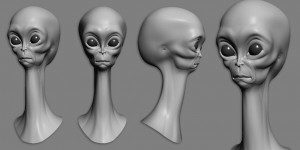 Some particularly gruesome incarnations of the alien invasion scenario have flooded our movie theatres of late, though this is nothing new. Hollywood and by extension, western culture, has been obsessed with the subject of violent contact with extraterrestrials for decades. Even before the advent of moving pictures on the silver screen Orson Welles presented his listening audience with a fright they never forgot, in his adaptation of H.G. Wells’ classic novel The War of the Worlds. One thing Hollywood has made clear is their caricature of humanities fear of visitation from another world.
Some particularly gruesome incarnations of the alien invasion scenario have flooded our movie theatres of late, though this is nothing new. Hollywood and by extension, western culture, has been obsessed with the subject of violent contact with extraterrestrials for decades. Even before the advent of moving pictures on the silver screen Orson Welles presented his listening audience with a fright they never forgot, in his adaptation of H.G. Wells’ classic novel The War of the Worlds. One thing Hollywood has made clear is their caricature of humanities fear of visitation from another world.
Since Louie Lumiere and his brother produced the first Cinematographe in 1895, in competition with Thomas Edison and his invention of the first Vitascope, an adaptation of his earlier Kinetoscope, in 1896, there have been somewhere in the area of 300 motion pictures featuring extraterrestrial life in some form. While not all of these films were apocalyptic, a great many offered a grim and gruesome vision of invasion, war and annihilation at the hands of an alien race.
You must be familiar with the story: after a miraculous arrival, wrapped in mystery and awe, one question teeters on the lips of every man, woman and child…what are their intentions? Shortly after, an all-out war ensues, pitting mankind against an unknown and enigmatic foe whose technological reach far exceeds our own. And with a great loss of life and an epic struggle worthy of Hollywood production, humanity ultimately prevails, whether by military might, universal cooperation or by the mysteries of nature, and either driving the alien marauders from our skies, or bringing their hulking ships crashing onto our lands.
 Even in-so-far as there are those among us who are unable or unwilling to discern between the truths of fiction and the falsities of reality, many have speculated on just what form such a visitation might take. Ultimately such speculation becomes a prediction (however un-provable) about not only the existence of, but the nature of extraterrestrial life in the universe. The sciences of Astronomy and Cosmology and Theoretical Physics have given us glimpses of what may be elsewhere in the cosmos. They speak of the probability of organic life being spread throughout our galaxy and beyond. They speak of the likely development of such life and the best-case chances of such life developing to some point that we might call it intelligent. And in fact the learned men, such as Stephen Hawking, Carl Sagan, Brian Green, Chris Impey, may be the best theoretical chance we have of defining exactly what or who we might face in the deep, dark void of space.
Even in-so-far as there are those among us who are unable or unwilling to discern between the truths of fiction and the falsities of reality, many have speculated on just what form such a visitation might take. Ultimately such speculation becomes a prediction (however un-provable) about not only the existence of, but the nature of extraterrestrial life in the universe. The sciences of Astronomy and Cosmology and Theoretical Physics have given us glimpses of what may be elsewhere in the cosmos. They speak of the probability of organic life being spread throughout our galaxy and beyond. They speak of the likely development of such life and the best-case chances of such life developing to some point that we might call it intelligent. And in fact the learned men, such as Stephen Hawking, Carl Sagan, Brian Green, Chris Impey, may be the best theoretical chance we have of defining exactly what or who we might face in the deep, dark void of space.
The standard position of mainstream science suggests that microbial life may indeed be abundant in the universe, and that the conditions needed for complex life – intelligent life – to evolve, are much too stringent and fleeting to have yielded to many more than a small handful of races in the entire history of the universe. This has been said to be a somewhat narrow view, often with decriers pointing out that intelligent life need not even be recognisable by humans. Though one might respond to that argument by stating that life that is unrecognisable by humans is moot, for if we cannot recognise it, we may as well be surrounded by it without end.
 So as can be seen, the field of speculation that surrounds the possibility of extraterrestrial life in the universe is somewhat muddy, and even still, most mainstream scientists refuse to discount the possibility that intelligent life might exist elsewhere, adding the caveat that the question is not simply of where, but of when. If we can agree that the possibility exists, can we speculate on the form and value of our contact with such a life?
So as can be seen, the field of speculation that surrounds the possibility of extraterrestrial life in the universe is somewhat muddy, and even still, most mainstream scientists refuse to discount the possibility that intelligent life might exist elsewhere, adding the caveat that the question is not simply of where, but of when. If we can agree that the possibility exists, can we speculate on the form and value of our contact with such a life?
This is a highly complex subject indeed, far more so than any science fiction writer is able or willing to admit, and for the sake of convenience, I will only be discussing a small portion of the nearly infinite number of variables in question below.
Speaking first to form; what would they look like? This is itself, a multi-faceted question, for the form of the visitor will dictate so much else about the nature and value of their visit. In the language of science, there are conceptual boundaries by which all matter must conform in the universe – these are the laws of physics. Scientists such as Albert Einstein and Stephen Hawking have, though their work, determined with as much certainty as can be found, that these laws of physics are universal, meaning that their limitations and basic functions are the same no matter where one might find himself in the universe. The effect of gravity on nearby objects of mass, the speed of light and the restrictions ensuing from that famous equation, and even the unchangeable direction of the arrow of time, as dictated by the second law of classicalthermodynamics.
 More controversially though, I would argue that some, if not many of the natural laws that govern life on earth also apply to life elsewhere in the universe. Namely, the unwritten laws associated with the process of evolution. This may seem somewhat obvious – how could anything develop to a state of comparable “life” as humanity without the use of an evolutionary mechanism and I agree, thought there are those who would not. It seems to me, that evolutionary biology is a universal law as well, or at the very least is part of one as yet undiscovered universal law. If this is the case, then it stands to reason that extraterrestrial life will also be subject to the never-ending march of evolution; that its current form is the result of millions if not billions of years of evolutionary development (more likely billions, as a convenient answer to their necessarily more advanced technology).
More controversially though, I would argue that some, if not many of the natural laws that govern life on earth also apply to life elsewhere in the universe. Namely, the unwritten laws associated with the process of evolution. This may seem somewhat obvious – how could anything develop to a state of comparable “life” as humanity without the use of an evolutionary mechanism and I agree, thought there are those who would not. It seems to me, that evolutionary biology is a universal law as well, or at the very least is part of one as yet undiscovered universal law. If this is the case, then it stands to reason that extraterrestrial life will also be subject to the never-ending march of evolution; that its current form is the result of millions if not billions of years of evolutionary development (more likely billions, as a convenient answer to their necessarily more advanced technology).
If we can reasonably assert the above, then there are some automatic assumptions that can be made about their form. Chiefly, that they would be a corporeal entity, with mass, shape, internal organs, sensory organs, limbs of some kind and locomotive abilities. This, of course, does not speak to the value of such form – we could not hope to predict bipedalism (walking on two legs), or even quadrapedalism (four legs) or any variation thereof, since the specific result of the evolutionary process on any foreign entity would be entirely dependant on their own alien environment. If the natural conditions of their world favoured the selection of octopedalism or even tripedalism, it would inevitably follow that our ET visitors would conform to that nature. The same would apply to sense organs, and even the configuration of body parts – one could equally expect to find a tripedal alien with no head and a mouth on its elbow (if one could identify its elbow), just as well as they might expect a bipedal visitor with a telescopic neck, whose belly and finger light up when comically convenient.
 Further, it would be entirely conceivable that such alien visitors could have evolved apparatus and biological processes for uses that we would find truly alien. In this vein one can imagine many such mechanisms: something equivalent to the mysterious human psi abilities, or rapid regeneration, and even the emission of plasmatic or acrid or totally unimaginable materials….just to name a few. Though as has been presented in recent films, any special abilities that our visiting aliens might possess, would be entirely incidental and any negative effect that they might have on Earth’s biology would be coincidental at best. As will be discussed later, it is inconceivable that an alien race could specifically evolve abilities that are specially adapted to aid or hinder human physiology, since our physiology would have had no impact whatsoever on the process of natural selection on their world.
Further, it would be entirely conceivable that such alien visitors could have evolved apparatus and biological processes for uses that we would find truly alien. In this vein one can imagine many such mechanisms: something equivalent to the mysterious human psi abilities, or rapid regeneration, and even the emission of plasmatic or acrid or totally unimaginable materials….just to name a few. Though as has been presented in recent films, any special abilities that our visiting aliens might possess, would be entirely incidental and any negative effect that they might have on Earth’s biology would be coincidental at best. As will be discussed later, it is inconceivable that an alien race could specifically evolve abilities that are specially adapted to aid or hinder human physiology, since our physiology would have had no impact whatsoever on the process of natural selection on their world.
The underlying point is simply that the Hollywood prediction thus far has pandered to an anthropocentric notion of alien form; typically bipedal, or in recent cases, tripedal, and with a discernable psychology to boot.
What we can predict with relative confidence is basic form.
As an extension of the Law of Attraction (gravitation), our gravity (the gravitational pull of the Earth’s mass on all objects within the field) dictates that massive and hulking alien creatures could not exist on Earth as they do in Hollywood. As gravity works by increasing the weight of an object exponentially based on its mass, any extraterrestrial visitor with a mass any larger than an elephant would be subject to crushing gravity and would likely collapse under it’s own weight. If the argument exists that such a creature could have a disproportionate mass/weight ratio due to unique biological properties, it would follow that such a creature would be so fragile and delicate that our environment would render it to be at the mercy of the slightest breeze. To suggest that any alien being of immense size could be balanced to our gravity so as to not be crushed under its own weight, and to not blow away on a breeze, is to be so naively anthropocentric that the argument is moot.
The result is that any extraterrestrial visitor who hopes to survive in our gravity, must conform to Sir Isaac Newton’s theory of gravitation, and as such is dictated to be of similar mass and weight as any other creature on Earth. This is not necessarily to say that an alien creature of immense size cannot exist, since the variable gravity of its home-world may be less than our own, wherein such a creature could exist there, it simply could not inhabit our planet.
While we cannot predict with any degree of accuracy how our visiting friends would orient their features, we can reasonably predict the quality of such features.
The First Law of Thermodynamics demands that all systems be open. Moreover, that no system is closed; meaning that biological systems, such as those that support the life of a human or an alien, are bound to both take in energy and to expel waste. Humans, as is well known, take in energy in two ways: 1) ingestion of food and 2) respiration. Transversely, we expel waste in two equally well known ways.
That said, it stands to reason and in fact must be, that any alien visitor would possess the ability to take in energy (in whatever form) as well as to expel waste products (again, in whatever form).
Almost all life on Earth, as with humans, depends exclusively on the radiant energy of our sun. We ingest that energy via plants that have, through photosynthesis, converted the sun’s energy into measurable packets and/or oxygen. Specifically, organelles called chloroplasts absorb and convert light energy into various compounds using carbon dioxide and water, ultimately expelling oxygen as a waste product.
 Most mammalian life on Earth benefits from photosynthesis, either by eating plants directly or by eating other animals that have either – eaten plants or in-turn eaten other animals that have eaten plants.
Most mammalian life on Earth benefits from photosynthesis, either by eating plants directly or by eating other animals that have either – eaten plants or in-turn eaten other animals that have eaten plants.
What’s important here is the idea that all biological beings must take in energy in some form, and on Earth all of that energy is derived from the sun’s radiation. Thus to survive, all biological beings must possess a faculty for taking in such energy and for converting it into usable form. In our case a mouth with the ability to break food items into manageable bits, an oesophageal passage to transport food material into the body, and a digestive system to process food stuff into usable nutrients. As well as lungs, bronchi, alveoli and a circulatory system for the intake and processing of oxygen and the expulsion of carbon dioxide (CO2). All of these components are necessary to support mammalian life in our atmosphere, though not all life on Earth is mammalian.
Most insects – while typically equipped with a mouth of sorts and being able to ingest food in the form of plant material, other insects and even small mammals and crustaceans – are not capable of taking in oxygen in the same manner as mammals. Insects breathe via a collection of microscopic tubules that permeate their exoskeletal structures, drawing oxygen directly into muscle tissue and organs without the use of lungs or a mammalian circulatory system. Often it is this feature that allows aquatic insects to remain submerged for what seems like an unreasonable amount of time, since water molecules are too large to be absorbed through the tubules and thus only oxygen can be taken in while under water.
So from photosynthesis, to aerobic energy conversion, to the direct absorbing of oxygen, we illustrate just how diverse the field of options is here on Earth, let alone throughout the universe. But the question remains, to predict the orientation of features of an alien body, one would need to predict with some accuracy precisely how said alien takes in nutrients from its environment (whether food stuffs and/or some equivalent to oxygen, if not oxygen itself).
 An extraterrestrial however, could not necessarily be said to be sustained by light and its derivatives as we are. Though if an alien did exist which did rely on solar radiation for survival, it would not necessarily follow that such an alien would be sustained by the specific type of radiation being expelled by our sun.
An extraterrestrial however, could not necessarily be said to be sustained by light and its derivatives as we are. Though if an alien did exist which did rely on solar radiation for survival, it would not necessarily follow that such an alien would be sustained by the specific type of radiation being expelled by our sun.
In addition to a means to ingest nutrient energy, such a creature would also require external sense organs of some variety in order to interact with their environment. In so far as we can only speculate to an extremely shallow depth on the conditions which might have selected for such organs in an alien species, we cannot confidently predict the actual form and value of such organs as they would relate to conditions on their planet, nor how they would interact with our planetary environment. It seems reasonable to conclude that all multi-cellular life requires organs that sense fluctuations in light and in sound vibration, though we can already see examples of life already on Earth that does not conform to this idea.
Once we make the leap from not knowing whether ET requires eyes or ears to assuming that they do, we can then predict with reasonable accuracy how such organs would be oriented. Though making such a leap would be unfounded. It could be conceivable that an alien species might sense their environment through methods that are heretofore unfathomable, and again, the evolution of such apparatus would be dependent only on selection pressure found in their native environment.
As below, if extraterrestrial life developed on a world that is analogous to our own, we might expect to see binocular vision, stereophonic auditory features and even olfactory features, though, as has been pointed out many times before, since there is no demand for our own noses, ears and eyes to be oriented in the manner we currently find, there would be no reason to expect extraterrestrial life to conform to the same conventions of facial structure. In fact, there could be argument to support the idea that alien “facial features” should be vastly different from our own.
Even among these assumptions there are hidden pitfalls; visual acuity in humans is vastly different than that of other mammalian life on Earth, not to mention aquatic, amphibian, avian and insect life. The basic premise of the eye remains the same across most species, an organ tasked with receiving light input from the environment, and sending corresponding signals to the brain to be translated into useful sensory information by a cortex of some kind. But what light inputs are received and what sensory information is useful depends entirely on the species at hand.
The visible light spectrum – a small swath of light radiation from the overall spectrum of electromagnetic energy emanating from our sun (as well as all other stars) – is called so because it is the range of electromagnetic radiation that we humans can process. Even among mammals, let alone the myriad of other kinds of life on our planet, there is vast difference in the specific spectrum or range of usable light energy between species. Nocturnal animals can consistently “see” much more of the infrared spectrum than we humans, while many insect species are able to detect much of the ultraviolet spectrum. In fact many plants utilise this feature found in many species of bee and butterfly, in order to make themselves more attractive to the insects, by way of evolving markings visible only in the ultraviolet spectrum, thereby increasing their (the plant’s) individual chances of procreating.
 From an admittedly anthropocentric position, it seems reasonable to claim that extraterrestrials likely will have eyes of some sort, though this is far from certain. If their environment is predominantly without light, we might find species that are kinetically sensitive to electromagnetic fluctuations in their immediate environment, much like many types of fish on Earth, including sharks. Or we might find that ET is visually able to detect light energy in a much larger band, say from low frequency radio waves to gamma ray radiation.
From an admittedly anthropocentric position, it seems reasonable to claim that extraterrestrials likely will have eyes of some sort, though this is far from certain. If their environment is predominantly without light, we might find species that are kinetically sensitive to electromagnetic fluctuations in their immediate environment, much like many types of fish on Earth, including sharks. Or we might find that ET is visually able to detect light energy in a much larger band, say from low frequency radio waves to gamma ray radiation.
A similar argument can be presented for olfactory senses, wherein the vast diversity of olfactory capabilities found in animal life on Earth is already staggering, as this is the product of the large but finite collection of environments available on the planet combined with the power of natural selection. Introducing other, more alien environments serves to introduce even more possibilities for the form and orientation of extraterrestrial features.
And so now that we’ve thoroughly confused the issue, it bears repeating. While we are not able to predict the form of life outside of our small solar system, we can predict certain qualities of such form, though still with a margin of error which leaves much to the imagination. Extraterrestrials must only conform to the laws of physics as they apply to their particular environment. Should life evolve elsewhere, say on a planet considered analogous to our own, it is conceivable that such life might bear certain resemblances to life on Earth, though this should not be thought of as a universal rule. For out of the infinite selection variables that have shaped life on Earth, we might have turned out quite different had the conditions of our own evolution varied even slightly.
Mankind sits atop his golden throne but for a small cup of chance, and the argument rages on. We are not the creation of some grand vision of intelligence and superiority; we are simply the product of a set of random genetic mutations along a mammalian ancestral path. From bipedal locomotion, to opposable digits, to binocular vision, to increased intracranial development, which ultimately allowed for the growth of a cortex that outperforms the minds of all other life on Earth. Evolution did not favour us, it does not favour us, and as such we cannot assume that the same process resulted in the same or even similar genetic mutations elsewhere in the universe.
Does that make us unique? Most definitely. Does that make us special? Perhaps. Does that make our form the inevitable outcome for all biological development in the universe? Absolutely not.
Part II of this piece will present arguments for and against the value of extraterrestrial contact, based on the above information.
